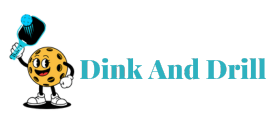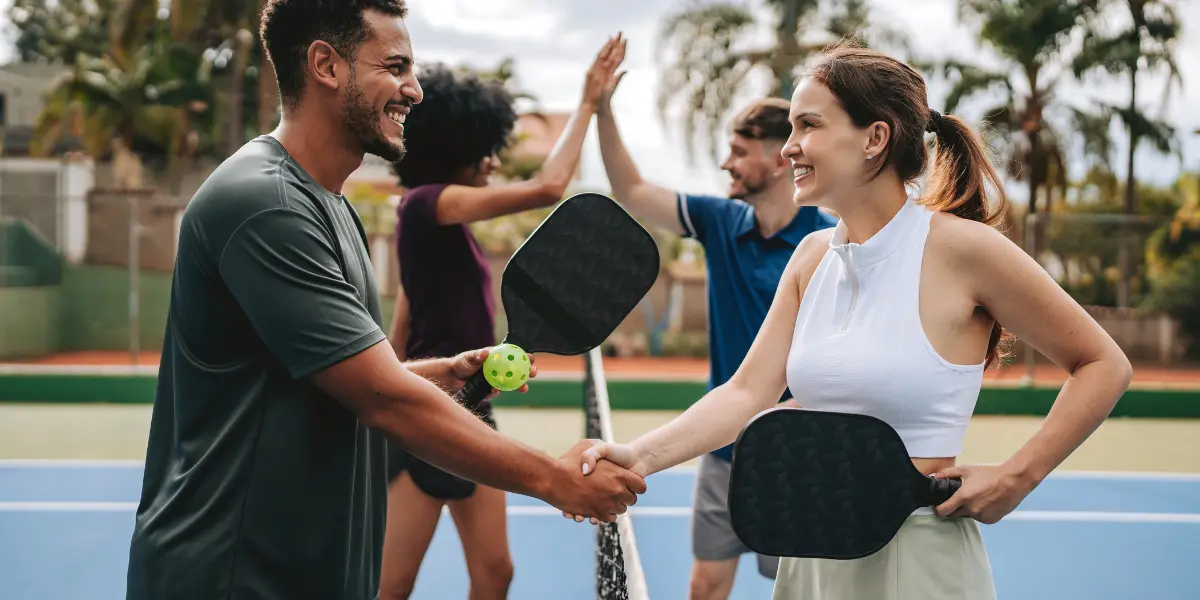Pickleball is often seen as a fun and social game, but many people overlook its fitness potential. A common question that comes up is. Does pickleball burn calories, and how many? The answer is yes, and quite a surprising amount depending on how you play. With fast-paced rallies, constant footwork, and short bursts of movement, pickleball offers a solid cardio workout.
It’s not just a pastime, it’s a full-body activity that helps burn fat, improve endurance, and support weight loss goals. This article dives deep into the actual calorie burn and what affects it, using accurate research and real numbers.
Does Pickleball Burn Calories?
Yes, pickleball absolutely burns calories, and not just a few. It’s a sport that combines elements of tennis, badminton, and ping-pong, requiring constant movement, quick reflexes, and bursts of energy. These movements engage multiple muscle groups at once and keep your heart rate elevated, which is the perfect formula for burning calories.
Unlike traditional workouts that can feel repetitive, pickleball keeps your body active through gameplay. The stop-and-go rhythm, lateral movements, and quick pivots make it an effective cardio workout, especially when played with moderate to high intensity.
Even casual games contribute to calorie expenditure, making it suitable for all fitness levels.
How Many Calories Do You Burn Playing Pickleball?
The number of calories burned during a game of pickleball isn’t fixed, it changes based on intensity, duration, player weight, and game style. However, we can still give a reliable estimate based on actual fitness data, player tracking, and published studies.
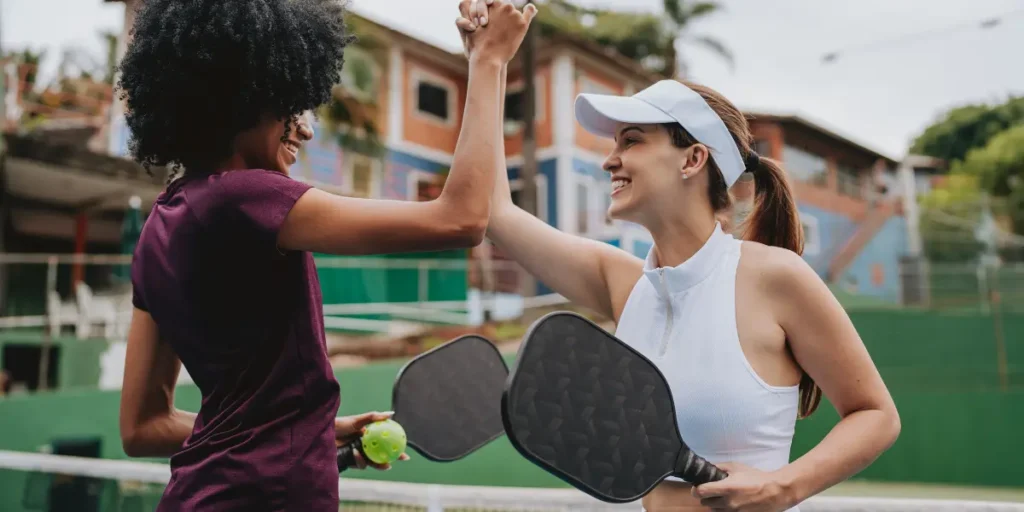
In general:
- Light play, like casual doubles with breaks, burns around 250–350 calories per hour.
- Moderate play, such as regular matches with steady movement, burns around 400–500 calories per hour.
- High-intensity play, like singles or competitive tournament games, can burn 600–800+ calories per hour.
These numbers make pickleball comparable to cycling, fast-paced walking, or even light jogging, especially when played at a higher intensity.
To better understand how body weight affects this, here’s a detailed breakdown:
Calories Burned Per Hour Based on Weight and Intensity
| Body Weight | Light Play (Casual Doubles) | Moderate Play (Recreational or Social Match) | High-Intensity Play (Singles/Competitive) |
|---|---|---|---|
| 120 lbs (54 kg) | 250 calories | 400 calories | 600 calories |
| 140 lbs (64 kg) | 280 calories | 430 calories | 650 calories |
| 160 lbs (73 kg) | 300 calories | 450 calories | 700 calories |
| 180 lbs (82 kg) | 330 calories | 480 calories | 750 calories |
| 200 lbs (91 kg) | 350 calories | 500 calories | 800 calories |
| 220+ lbs (100+ kg) | 370+ calories | 530+ calories | 850+ calories |
These are hourly estimates, so if you play for 90 minutes or multiple rounds, your total calorie burn increases significantly. For instance, a 160 lb player in a moderately intense 90-minute session can burn around 675–700 calories, which is more than one full gym workout session for many people.
This is one reason why more and more players are turning to pickleball, not just for fun, but as part of their weight loss and cardio fitness routine.
Factors That Influence Calorie Burn in Pickleball
Not every game of pickleball burns the same number of calories. The actual amount depends on several key factors that affect how hard your body works during play. Here are the main variables that make a difference:
- Body Weight: Heavier individuals naturally burn more calories because their bodies use more energy to move.
- Game Intensity: A slow-paced doubles match will burn fewer calories than a fast-paced singles game with constant movement and quick returns.
- Duration of Play: The longer you play, the more energy you expend. Even short games can add up if you’re playing multiple rounds.
- Skill Level: Beginners might not move as much, but intermediate or advanced players cover more ground, make quicker moves, and sustain higher intensity.
- Court Type: Outdoor courts in warm weather can increase your heart rate due to added environmental effort. Indoor play, while controlled, may not push the body as hard unless you raise the pace.
Understanding these factors helps players better estimate their personal calorie burn and adjust their game style to align with their fitness goals.
Singles vs Doubles: Which Burns More Calories in Pickleball?
The style of pickleball you play, singles or doubles, has a big impact on how many calories you burn. Singles matches typically involve much more movement since you’re responsible for covering the entire court alone. That means more running, quicker direction changes, and less time to rest between points.
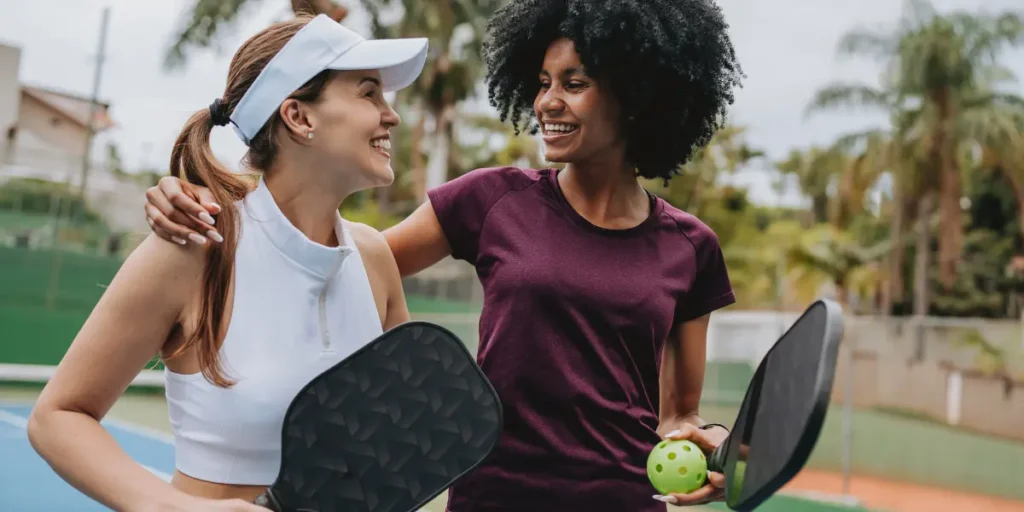
In contrast, doubles play allows each player to cover less ground. The intensity tends to be lower, especially in casual or social games. While doubles is still active and engaging, it simply doesn’t push the cardiovascular system as hard as singles does.
Here’s a comparison:
| Game Type | Calories Burned (Approx.) | Movement | Best For |
|---|---|---|---|
| Singles | 500–800+ per hour | High | Cardio & Weight Loss |
| Doubles | 250–450 per hour | Moderate | Low-impact Fitness & Social Play |
If your goal is to burn more calories, improve endurance, or lose weight faster, Pickleball singles is the better option. But for beginners or older adults looking for steady movement and social fun, doubles is perfect.
Pickleball as a Cardio Workout
While pickleball may not seem as intense as running or HIIT at first glance, it offers a surprising amount of cardiovascular benefit. The sport involves short bursts of speed, constant lateral movement, and dynamic changes in direction, all of which raise the heart rate effectively.
During moderate to intense matches, players often maintain a heart rate between 120–160 bpm, which qualifies as a light to moderate cardio zone for most adults. This helps improve:
- Heart health
- Blood circulation
- Lung capacity
- Overall stamina
What makes pickleball unique is that you get these benefits without the joint strain of running or high-impact sports. That’s why it’s becoming popular not just for weight loss, but also as a long-term fitness solution for adults of all ages, especially those looking for a low-impact cardio option.
Health Benefits of Playing Pickleball
Improves Balance and Coordination
Pickleball involves quick side-to-side movements, sudden stops, and changes in direction. These motions naturally improve your coordination and balance over time. This is especially helpful as you get older because better balance reduces the risk of falls and injuries in everyday life.
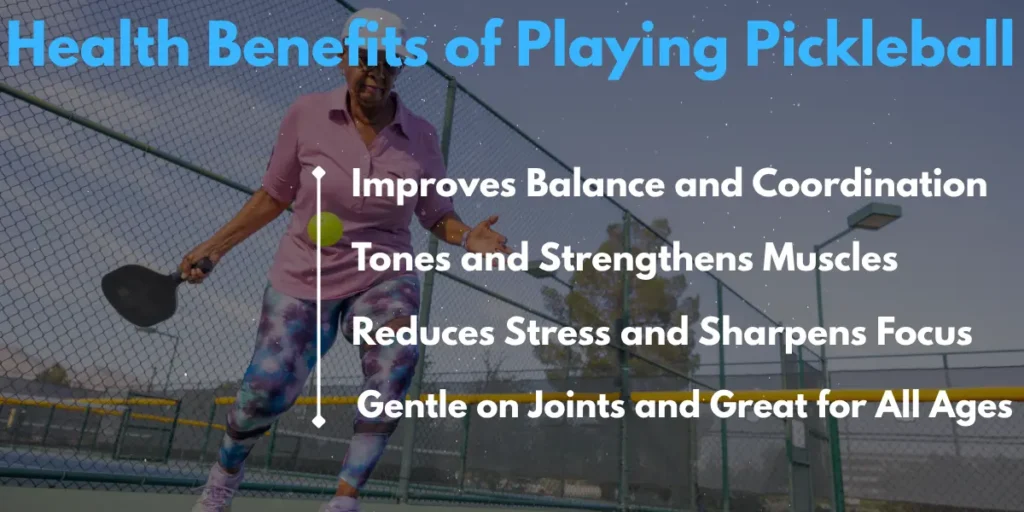
Tones and Strengthens Muscles
Even though it’s not a heavy-weightlifting activity, pickleball still works multiple muscle groups. Your legs get stronger from constant movement and lunges, while your arms, shoulders, and core get engaged every time you serve, hit, or return the ball. With regular play, you’ll likely notice more toned muscles and better overall strength.
Reduces Stress and Sharpens Focus
Playing pickleball requires concentration, timing, and strategy. It keeps your mind engaged while your body moves, which makes it easier to forget daily stress. Many players say that after a game, they feel more mentally refreshed and in a better mood. This makes pickleball not just good for your body, but also for your mental health.
Gentle on Joints and Great for All Ages
One of the best parts of pickleball is that it’s low-impact. That means it’s easier on the knees, hips, and ankles compared to sports like running or basketball. Because of this, it’s a great option for older adults, people recovering from injury, or anyone who wants to stay active without putting too much strain on their joints.
In short, pickleball is not just a way to burn calories, it’s an activity that supports long-term health in a way that’s fun, sustainable, and accessible for almost everyone.
How to Maximize Calorie Burn While Playing Pickleball
If your goal is to burn more calories while playing pickleball, there are a few simple ways to make your games more physically effective, without taking the fun out of it. The key is to increase movement, stay active between points, and play with more intensity.
Choose Singles Over Doubles When Possible
Playing singles means you’re covering the entire court on your own. This increases your steps, movements, and heart rate throughout the match. If you’re aiming for more calorie burn, try to include at least one singles session in your routine.
Keep the Pace Up
Long breaks between points or games can reduce your overall calorie burn. Try to shorten rest times, stay moving between plays, and keep the momentum going. Even light jogging in place or practicing footwork while waiting can help.
Play Longer Sessions or More Games
Naturally, the longer you play, the more calories you burn. If you usually play for 30 minutes, try extending your session to 45 minutes or an hour. You can also break it into sets—two 30-minute rounds with a short break in between can be very effective.
Add Movement-Heavy Drills
Incorporate warm-up drills or footwork exercises before your matches. Practicing serves, volleys, and quick side steps for 10–15 minutes adds extra activity and helps you get into a more energetic rhythm during games.
Focus on Intensity, Not Just Duration
It’s not just about how long you play, it’s also about how hard you play. A 30-minute high-intensity game can burn more calories than an hour of slow-paced play. Try to stay competitive, hustle for every ball, and challenge yourself during rallies.
By adjusting how you play, even slightly, you can easily increase your calorie burn and turn pickleball into a powerful part of your fitness routine.
Pickleball vs Tennis and Other Activities Calorie Comparison
Pickleball burns a decent amount of calories, but to understand its true impact, it helps to compare it with other popular sports and exercises. The chart below shows the estimated calories burned per hour by a person weighing around 160 pounds (73 kg):
| Activity | Calories Burned (Approx. per Hour) |
|---|---|
| Walking (3.5 mph) | 270–300 |
| Pickleball (light) | 300–350 |
| Pickleball (moderate) | 400–500 |
| Pickleball (intense) | 600–700 |
| Doubles Tennis | 450–600 |
| Singles Tennis | 600–850 |
| Cycling (12–14 mph) | 560–700 |
| Jogging (5 mph) | 590–650 |
| Swimming (vigorous) | 600–750 |
| Basketball (casual) | 400–500 |
| Badminton (recreational) | 350–450 |
How Pickleball Compares to Other Workouts
- Singles tennis burns more calories than pickleball because it involves a faster pace, greater court coverage, and continuous running.
- Doubles tennis is closer to moderate pickleball, depending on the intensity and how competitive the match is.
- Pickleball at high intensity comes very close to activities like jogging, swimming, and cycling, especially in singles play or competitive formats.
- For many people, pickleball is easier to stick with consistently because it’s low-impact, social, and less intimidating than traditional workouts.
So while it may not be the absolute top in calorie burn, pickleball offers one of the best combinations of fitness, fun, and long-term sustainability.
Track Your Calories During Pickleball
The easiest way is to track your calories during pickleball, just use a fitness tracker or smartwatch, like an Apple Watch, Fitbit, or Garmin. Most of these devices can track your heart rate, steps, and time played to estimate total calories burned. Some even have a “Pickleball” workout mode or let you manually log the session.
If you don’t use a tracker, you can also use fitness apps like MyFitnessPal or Cronometer. Just enter your weight, duration of play, and intensity level, and the app will estimate the calories burned.
FAQs
For most people, 30 minutes of casual doubles play burns around 150–200 calories. In more intense singles matches, the number can reach 300–400 calories in just half an hour, depending on your weight and effort level.
Yes, when combined with a healthy diet, pickleball can support weight loss. Regular sessions, especially singles or competitive play, help burn fat, increase activity levels, and improve metabolism over time.
Absolutely. Pickleball is low-impact and easy on the joints, making it ideal for older adults. Even light play helps improve balance, burn calories, and maintain heart health without putting too much strain on the body.
While it’s not a strength-training workout, pickleball still works your legs, arms, shoulders, and core. Over time, this helps with muscle toning and endurance, especially if you play regularly.
Pickleball burns more calories per hour than walking, especially if played at a moderate to high intensity. It also engages more muscles and keeps your heart rate higher, making it a more effective workout for fat loss.
Conclusion
So, does pickleball burn calories? Yes, and a surprising amount, depending on how you play. Whether you’re looking to lose weight, stay active, or simply have fun while moving your body, pickleball is a solid option. With calorie burns ranging from 300 to over 700 per hour, it holds up well against many traditional workouts.
What sets it apart is how easy it is to stick with. It’s low-impact, enjoyable, and accessible to players of all ages and fitness levels. Plus, the added benefits, like improved balance, muscle tone, and mental focus, make it more than just a calorie-burning sport.
If you’re thinking of adding a fun, effective workout to your routine, pickleball might be exactly what you need.
